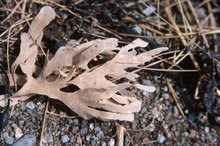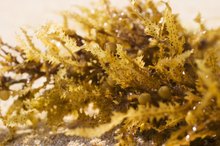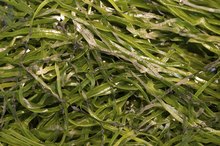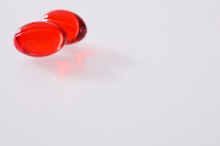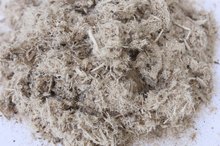Laminaria Extract & Weight Loss
Commonly known as kelp, Laminaria digitata is a sea vegetable that is most typically used as a source of certain nutrients. Kelp may have many other uses for your health, however, including benefits for weight loss. Before you begin taking Laminaria extract to promote weight loss, consult your doctor to discuss the potential risks and proper dosage.
If you are experiencing serious medical symptoms, seek emergency treatment immediately.
Identification
Kelp is a type of brown seaweed that can be different species belonging to the Laminaria genus, but the most common form is Laminaria digitata, according to the University of Michigan Health System. Kelp is rich in vital minerals like iodine, iron, magnesium, potassium and calcium. Laminaria species also contain high levels of folic acid and numerous other vitamins, making it a nutrient-rich food source in many countries, notes the University of Pittsburgh Medical Center. Kelp is also made into extracts and other medicinal remedies that are used for specific health purposes.
- Kelp is a type of brown seaweed that can be different species belonging to the Laminaria genus, but the most common form is Laminaria digitata, according to the University of Michigan Health System.
- Laminaria species also contain high levels of folic acid and numerous other vitamins, making it a nutrient-rich food source in many countries, notes the University of Pittsburgh Medical Center.
Function
Role of Guggul Extract in Weight Loss
Learn More
Kelp’s high concentrations of iodine can help treat an iodine deficiency, notes the University of Michigan Health System. The iodine in kelp may also increase your metabolism, Drug Digest says. Laminaria species contain large amounts of soluble and insoluble fibers that have laxative effects in the intestines, both by stimulating intestinal contractions and by bulking stools. Additionally, kelp could offer antihypertensive, antiviral and anticancer actions, according to the University of Pittsburgh Medical Center.
- Kelp’s high concentrations of iodine can help treat an iodine deficiency, notes the University of Michigan Health System.
Effects
Laminaria’s iodine content may increase your metabolism, promoting weight loss, Drug Digest says. Unfortunately, no conclusive scientific research has proven that kelp can indeed support or induce weight loss in overweight or obese individuals, notes the University of Pittsburgh Medical Center. Talk with your physician before taking Laminaria extract for any health purpose.
Other Uses
How to Take Kelp Powder
Learn More
Applied to the skin, kelp may help ease skin irritation and promote wound healing. No widely-accepted medical research supports the use of Laminaria extract to prevent or treat any health condition, however.
Warning
Taking large amounts of Laminaria can provide your body with excessive levels of iodine, which could alter your thyroid function, warns the University of Michigan Health System. If you have a thyroid disorder -- especially hyperthyroidism or overactive thyroid -- talk with your healthcare provider before taking kelp extract. You might experience side effects like acne, stomach upset, diarrhea, nausea or a metallic taste in your mouth while taking Laminaria extract, Drug Digest says. The high levels of potassium in kelp could cause hyperkalemia, or too-high potassium levels, if you’re taking a potassium-sparing diuretic. Kelp extract could also interact negatively with other medications, such as blood-thinners like Coumadin and various drug to treat hyperthyroidism, hypothyroidism or other thyroid conditions.
- Taking large amounts of Laminaria can provide your body with excessive levels of iodine, which could alter your thyroid function, warns the University of Michigan Health System.
Related Articles
References
- Seaweed, kelp, raw. FoodData Central. U.S Department of Agriculture. Published April 1, 2019.
- Cherry P, O’Hara C, Magee P, McSorley E, Allsopp P. Risks and benefits of consuming edible seaweeds. Nutr Rev. 2019;77(5):307-329. doi:10.1093/nutrit/nuy066
- Admassu H, Gasmalla MAA, Yang R, Zhao W. Bioactive peptides derived from seaweed protein and their health benefits: Antihypertensive, antioxidant, and antidiabetic properties. J Food Sci. 2018;83(1):6-16. doi:10.1111/1750-3841.14011
- Thomas I, Siew LQC, Watts TJ, Haque R. Seaweed allergy. J Allergy Clin Immunol Pract. 2019;7(2):714-715. doi:10.1016/j.jaip.2018.11.009
- National Institutes of Health Office of Dietary Supplements. Iodine. Updated December 6, 2019.
Resources
Writer Bio
Sarah Terry brings over 10 years of experience writing novels, business-to-business newsletters and a plethora of how-to articles. Terry has written articles and publications for a wide range of markets and subject matters, including Medicine & Health, Eli Financial, Dartnell Publications and Eli Journals.

